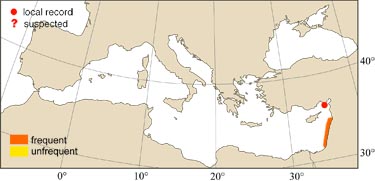 photo : David Darom |
Relevant synonyms
|
|
SHORT
DESCRIPTION
color : body silver-grey with five black stripes along the body. The upper runs near dorsal fin base. The third runs from the snout through the eye to caudal peduncle. The lower stripe runs along ventral surface, curving upward ending in front of pectoral fin base. Large black spot surrounded by yellow background on the caudal peduncle. Another black spot on the dorsal surface of caudal peduncle. size : common 2-6 cm (max. 8 cm). |
DISTINGUISHING CHARACTERISTICS
BIOLOGY / ECOLOGY
habitat : during the day among corals and rocks, at night found in shallow open areas near soft substrate. |
|
1st
MEDITERRANEAN RECORD
|

|
|
DISTRIBUTION
|
ESTABLISHMENT SUCCESS
speculated reasons for success :
|
|
|
MODE OF
INTRODUCTION |
IMPORTANCE TO
HUMANS |
|
KEY
REFERENCES
|
|